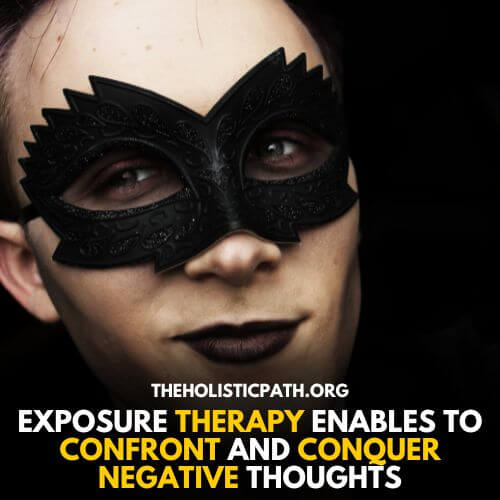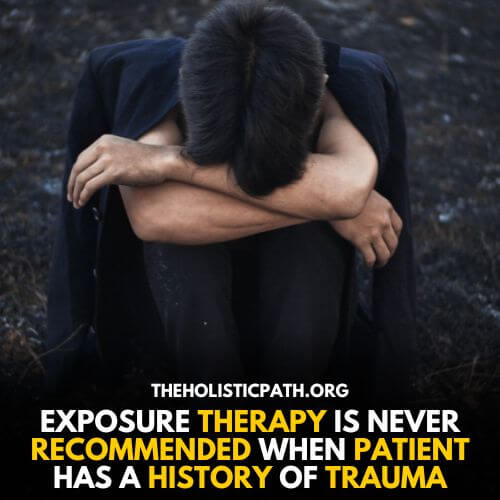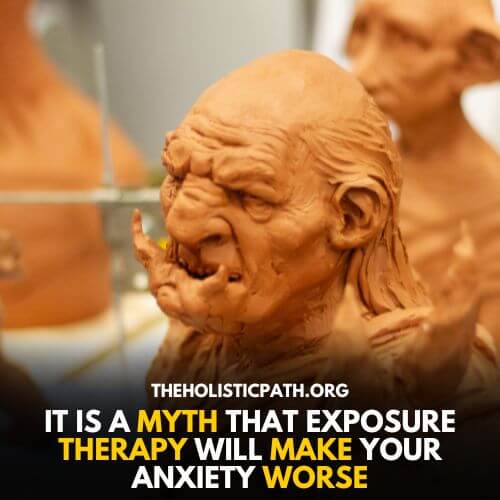When it comes to treating anxiety and other mental health issues, exposure therapy can be a powerful tool – but only when used responsibly. While often effective, there are certain cases in which exposure therapy should not be used. So, in this article, we’ll discuss when is exposure therapy not recommended.
Generally speaking, if the patient has severe mental health problems such as psychosis or schizophrenia, this type of therapy is not recommended due to the inherent risks involved. Additionally, individuals with a history of violence or substance abuse should generally avoid exposure therapy since too much emotional stimulation could trigger deleterious behaviors.
Ultimately, no two cases are the same, so it’s important to consult your doctor closely before starting any therapeutic intervention.
How Does Exposure Therapy Work?
Exposure therapy works by gradually exposing the patient to their fear or anxiety triggers. This is done over a pre-determined period of time in a safe and controlled environment.
The goal is to help the patient learn how to cope with and manage his/her anxiety or fear response. During exposure sessions, the therapist may use various techniques to help the patient become more comfortable with the fear or anxiety trigger.
The therapist may use cognitive restructuring, relaxation techniques, and even role-play scenarios to help the patient work through their fears.
How Long Does Exposure Therapy Take?
The length of exposure therapy depends on factors such as the type and severity of the fear or anxiety, as well as the patient’s ability to cope with their triggers. Generally speaking, short-term exposure therapy (6-12 sessions) can be beneficial for milder fears and anxieties, while longer-term treatment may be necessary for more severe issues.
In some cases, multiple exposure sessions may be needed to help the patient reach their goals and reduce or eliminate their fear or anxiety.
6 Conditions Exposure Therapy Helps With?
Exposure therapy can be beneficial for a variety of conditions, including:
- Phobias, such as fear of flying or being in public places
- Post-traumatic stress disorder (PTSD)
- Obsessive-compulsive disorder (OCD)
- Panic disorder
- Social anxiety disorder
- Generalized anxiety disorder (GAD).
6 Major Pros Of Exposure Therapy To Get Rid Of Mental Illnesses
Exposure Therapy is a proven therapeutic practice that helps those living with anxiety, fear, and PTSD. It enables individuals to confront and conquer their negative thoughts, challenging them to face the situation or object they’ve been avoiding.
Here are a few advantages of Exposure therapy:
- It’s Effective: Exposure therapy has been proven to be an effective treatment for a variety of conditions, including PTSD, OCD, phobias, panic disorder, and social anxiety.
- It Can Be Used In Conjunction With Other Therapies: Exposure therapy can be combined with other therapies such as cognitive-behavioral therapy (CBT) for added benefit.
- It Helps Build Coping Mechanisms: The exposure sessions help the patient confront their fear or anxiety triggers in a safe and controlled environment, which helps them learn how to cope and manage their response better in real-world situations.
- It Enables Patients To Feel Empowered: By confronting their fears in an exposure session, patients can feel empowered and in control of their emotions and reactions.
- It Can Reduce The Need For Medication: By helping the patient learn how to manage their fear or anxiety response, exposure therapy can enable them to reduce or eliminate the need for medication.
- It Is Easily Accessible: Exposure therapy is widely available from qualified mental health professionals such as therapists, psychologists, and psychiatrists.

6 Main Cons of Exposure Therapy To Be Aware Of
The concept of exposure therapy can be daunting; some find the idea of purposely exposing oneself to their deepest fears unappealing and counterproductive. Here are a few disadvantages of Exposure therapy:
- It Can Be Stressful: The exposure sessions can be stressful, and some patients may not find it comfortable to confront their fear or anxiety triggers in this manner.
- It May Not Work For Everyone: Exposure therapy is not effective for everyone and there are cases where other treatments may be more suitable.
- It Can Trigger An Anxiety Episode: In rare cases, exposure therapy can trigger a panic attack or anxiety episode if the patient is not prepared for the session or is unable to cope with confronting their fear or anxiety triggers.
- There Is A Risk Of Retraumatization: Some of the exposure methods used can cause retraumatization if they are too intense or triggering for the patient.
- It Can Be Costly: Exposure therapy can be costly, as it often requires multiple sessions to work through the fear or anxiety triggers.
- It Requires A Dedicated Professional: Exposure therapy requires a dedicated professional who is experienced in treating various mental health conditions and creating customized exposure sessions for each patient.
6 Potential Conditions When Is Exposure Therapy Not Recommended
Unfortunately, exposure therapy is not always recommended for everyone. Here are four situations in which this type of treatment may not be the best option:
1. When Symptoms Are Severe and Debilitating
If a person’s anxiety or fear response is so severe that it prevents them from leaving their house, participating in daily activities, or even engaging in conversations with others, then exposure therapy may not be the most effective approach to take. In these cases, more intensive treatments such as cognitive-behavioral therapy (CBT) or medication may be necessary to manage the symptoms.
2. When a Patient Has a History of Trauma
Exposure therapy can be beneficial for treating PTSD but it should only be used after other forms of treatment have been exhausted. If a patient has experienced significant trauma, then exposure therapy may not be the best approach as it could potentially re-traumatize them.
3. When There Is an Underlying Medical Condition
Exposure therapy should never be used in isolation and should always be combined with other forms of treatment such as medication or psychotherapy. In cases where there is an underlying medical condition that needs to be addressed, then exposure therapy may not be the best option for treating the problem.
4. When Symptoms Are Caused by Substance Abuse
Exposure therapy can help some people cope with their fear or anxiety, but if these feelings are related to substance use, it is important to seek professional help for addiction issues first before attempting any type of psychological intervention.
5. When the Patient Is Not Mentally Prepared
Exposure therapy can be a difficult and daunting process, so it is important to make sure that the patient is mentally prepared before entering into exposure sessions. If they are not ready or do not feel comfortable with the approach then it may be best to try another form of treatment first.
6. When There Are Co-Occurring Disorders
It is important to determine whether any underlying mental health conditions such as depression or bipolar disorder may be contributing to the fear or anxiety symptoms before beginning an exposure program. If this is the case, then it may be necessary to seek additional treatments for those conditions in order to fully address the issue.

Is Exposure Therapy Cruel?
No, exposure therapy is not cruel. While it can be difficult and stressful for the patient to confront their fear or anxiety triggers in a controlled setting, the goal of this type of treatment is to help the patient understand and manage their emotions in a more positive way.
Exposure therapy should always be customized to the individual’s needs and used in conjunction with other forms of treatment such as medication or psychotherapy. Furthermore, exposure sessions should never be so intense that it causes retraumatization for the patient.
If done correctly and safely, exposure therapy can be an effective way for people to learn how to cope with their fear or anxiety responses in order to lead healthier lives.
8 Myths About Exposure Therapy To Negate
Exposure therapy is a powerful form of treatment for anxiety and phobias that has shown positive results in research studies. Unfortunately, there are many myths about this type of psychotherapy that paint an inaccurate picture of what’s involved and prevent people from getting the help they need.
Here are a few:
- Exposure therapy is a one-time treatment: False. Exposure therapy typically requires multiple sessions in order to be effective and can take months or even years to achieve the desired result.
- Exposure therapy is only for people with severe anxiety disorders: False. While exposure therapy can be used for more severe anxiety disorders, it can also be used to help people cope with less extreme forms of fear and anxiety as well.
- Exposure therapy means facing your fears alone: False. While some exposure sessions may require an individual to confront their fear on their own, many therapists use other techniques such as Cognitive Behavioral Therapy (CBT) or Eye Movement Desensitization and Reprocessing (EMDR) which involve the therapist in guiding the patient through their fear triggers.
- Exposure therapy is only for adults: False. Exposure therapy can be beneficial for children, adolescents, and adults alike. It is important to remember that exposure sessions should be tailored to the individual’s age, needs, and level of comfort.
- Exposure therapy is dangerous: False. While there are some risks associated with exposure therapy (such as retraumatization), when done correctly, under the guidance of an experienced therapist it can be a safe and effective way to treat anxiety disorders.
- Exposure therapy will make your anxiety worse: False. With the right support and structure, exposure therapy has been shown to reduce fear responses over time and allow people to better manage their anxiety.
- Exposure therapy is not evidence-based: False. Research has shown that exposure therapy can be an effective way to treat anxiety disorders and can help people learn how to better cope with their fears or anxieties in a safe, controlled setting.
- Exposure therapy doesn’t work: False. Studies have found that when used as part of an overall treatment plan, exposure therapy can be highly effective in reducing fear responses and helping people lead healthier lives.

Conclusion
Exposure therapy is a very powerful technique for managing anxiety and phobias, but it should always be used with caution. While it can often produce amazing results and help people overcome some of their deepest fears, there are certain cases when this form of treatment may not be the best choice.
People who have suffered from trauma or severe mental health disorders such as depression, PTSD, trauma, or schizophrenia may find exposure therapy to be too overwhelming. People suffering from psychosis, too, are not typically good candidates due to the danger that their distorted beliefs could present in certain situations.
Furthermore, if the client is experiencing an acute period of stress or depression, they may not have the psychological strength necessary to engage in exposure therapy.
Ultimately though, it’s important to discuss any possible treatment options with your doctor before beginning anything as they will know best which approach suits you.
Frequently Asked Questions
What types of individuals should not use exposure therapy?
Exposure therapy is not typically recommended for individuals who are currently struggling with psychosis, severe mental illnesses, personality disorders, or other unstable mental health conditions.
Individuals who have experienced extreme trauma (e.g. rape, torture) may also be advised to avoid exposure therapy as a treatment option.
Additionally, those who may lack the insight or capacity to understand and participate in the therapy process are usually discouraged from using exposure therapy.
What is the risk of using this type of therapy for certain individuals?
For any individual with a mental illness that could be destabilized by exposure therapy–such as schizophrenia, bipolar disorder, and severe depression–the risk involved can potentially outweigh the rewards.
This can be especially problematic if these individuals do not have adequate family or social support and/or access to appropriate psychiatric care; they may end up experiencing an exacerbation of their symptoms after undergoing the treatment instead of an improvement in functioning or well-being.
Can exposure therapy make OCD worse?
Exposure therapy is generally considered to be a safe and effective treatment for OCD, but it can have the potential to make OCD worse if not administered correctly.
If a person with OCD is exposed to situations or objects that increase their anxiety without having some form of coping mechanisms – such as relaxation techniques or cognitive behavioral therapy – then this could lead to a worsening of the symptoms.
Additionally, if a person is exposed to too many triggers at once then this could also have a negative effect on their OCD.
It is important for an experienced therapist to work closely with the individual when carrying out exposure therapy in order to ensure that it is done in a safe and controlled manner.
If done correctly, however, exposure therapy can be an effective way of reducing OCD symptoms.
Does exposure therapy increase anxiety?
Exposure therapy is known to increase anxiety in the short term, as it involves a person being exposed to triggers that cause them distress. However, it also helps people learn how to cope with their anxiety and over time can lead to a decrease in symptoms.
It is important for therapists to monitor exposure sessions closely and provide supportive techniques such as relaxation exercises and cognitive behavioral therapy.
This will help to ensure that the person is able to cope with their anxiety, which should result in a decrease in symptoms over time.
In some cases, exposure therapy can lead to an increase in anxiety if not handled correctly or if too many triggers are presented at once.
Therefore, it is important for an experienced therapist to work closely with the individual to ensure that exposure therapy is being done safely and effectively.
Why is exposure therapy controversial?
Exposure therapy is sometimes considered controversial because of the potential for it to increase anxiety in the short term. Additionally, exposure therapy can be a difficult and emotionally taxing experience for some people, particularly those with severe OCD.
It is important that an experienced therapist works closely with the individual to ensure that they are able to cope with their anxiety and provide methods for managing it.
Despite the potential risks, exposure therapy is generally considered to be a safe and effective treatment for OCD when done correctly.
Therefore, there is still much debate about whether or not this type of therapy should be used on individuals with severe OCD.
What happens to the brain during exposure therapy?
Research suggests that exposure therapy can lead to changes in the brain, particularly in areas related to fear and anxiety. During exposure therapy, a person is exposed to triggers that cause them distress and this activates the amygdala, which is responsible for producing fear-related responses.
However, with repeated exposures over time, it is believed that the brain can learn new coping strategies and become less sensitive to these triggers.
This may explain why exposure therapy is an effective treatment for OCD, as it can help to reduce the fear response that is associated with the disorder.
Additionally, exposure therapy has been found to lead to increased activity in areas of the brain related to executive functioning and decision-making, indicating that exposure therapy may help improve these skills.
Is EMDR more effective than exposure therapy?
EMDR (Eye Movement Desensitization and Reprocessing) is a type of therapy that has been found to be effective in treating trauma and anxiety disorders. While both EMDR and exposure therapy are considered effective treatments for OCD, there is no clear indication that one method is more successful than the other.
Different people may respond better to different methods of therapy, so it is important for an individual to work with a therapist to determine which type of treatment will be most beneficial for them.
Additionally, both EMDR and exposure therapy may be used in combination with other treatments such as medication or cognitive behavioral therapy in order to achieve the greatest benefits.
How do you feel after exposure therapy?
The effects of exposure therapy can vary greatly from person to person. Generally speaking, people who have completed a course of treatment often report feeling more in control of their anxiety and better able to cope with stressful situations.
Additionally, many individuals feel relieved that they no longer have to avoid triggers or engage in rituals associated with OCD.
It is important for individuals to remember that there may be some initial discomfort or increase in anxiety with exposure therapy, but this is part of the process and should improve over time.
With help from an experienced therapist, individuals are often able to manage their anxiety symptoms more effectively following exposure therapy.
Are there other forms of treatment that could be preferable to overexposure therapy for certain individuals?
Yes! Depending on what issues someone is dealing with, there are many different types of treatments available that may be more suitable alternatives than exposure therapy for certain individuals–especially those with mental illnesses that would put them at too high a risk if treated via this method (e.g., psychosis, severe depression).
These alternative forms include psychodynamic therapies like psychoanalysis, cognitive-behavioral therapies such as dialectical behavior therapy (DBT), medications such as antidepressants or antipsychotics, and holistic approaches like art or music therapy.
References:
David Sars (August 5, 2015). On the use of exposure therapy in the treatment of anxiety disorders: a survey among cognitive behavioral therapists in the Netherlands. https://www.ncbi.nlm.nih.gov/pmc/articles/PMC4525733/
Sara Markowitz and Michael Fanselow (March 13, 2020). Exposure Therapy for Post-Traumatic Stress Disorder: Factors of Limited Success and Possible Alternative Treatment. https://www.ncbi.nlm.nih.gov/pmc/articles/PMC7139336/
Karen Moses ( July 27, 2021). Utilization and predictors of use of exposure therapy in the treatment of anxiety, OCD and PTSD in an Australian sample: a preliminary investigation. https://bmcpsychology.biomedcentral.com/articles/10.1186/s40359-021-00613-7
